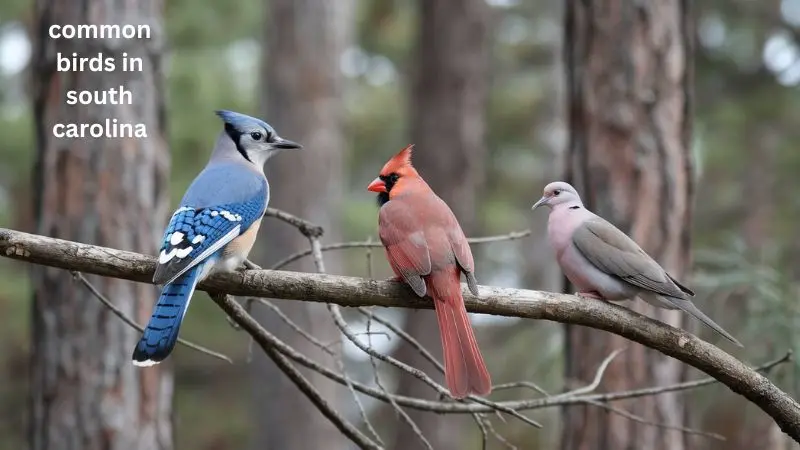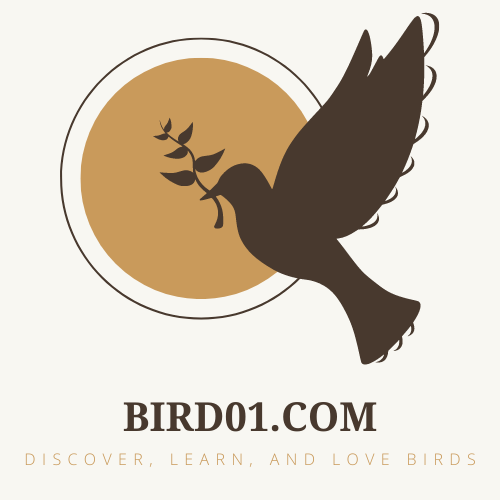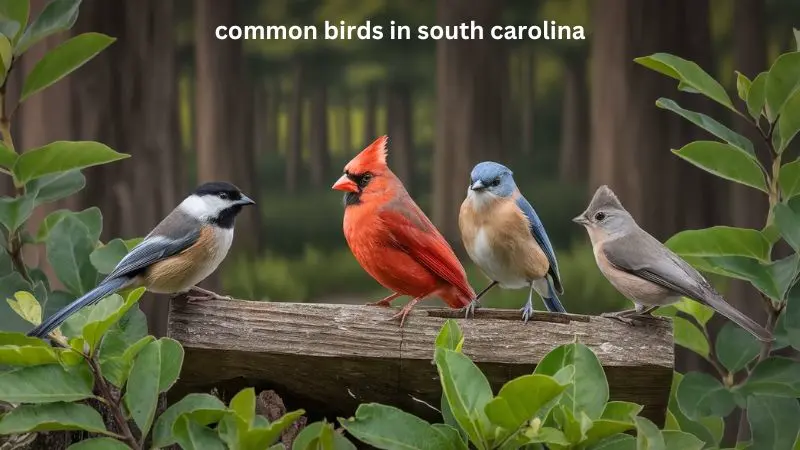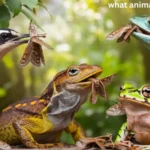South Carolina, known for its diverse ecosystems, offers an incredible array of bird species. From the tranquil shores of the Atlantic coastline to the vast forests of the Upstate, the Palmetto State provides birdwatchers and nature enthusiasts with ample opportunities to observe a rich variety of avian life. Whether you’re an experienced ornithologist or a casual birdwatcher, the common birds of South Carolina will not only captivate you with their beauty but also with their behaviors and habitats. This guide from Bird01.com introduces some of the most common birds that thrive in the state, offering a comprehensive overview of species you might encounter in your backyard, local parks, or wilderness reserves.
Some Common Birds In South Carolina
Northern Cardinal (Cardinalis cardinalis)
The Northern Cardinal, South Carolina’s official state bird, is one of the most recognizable and beloved birds in the state. Known for the male’s brilliant red plumage and the female’s more subtle brownish-red tones, this species is found throughout the year. Cardinals prefer woodland edges, gardens, and suburban areas where food, particularly seeds and fruits, is abundant. Their distinctive “cheer-cheer-cheer” song adds to their charm, making them a favorite among residents and birdwatchers alike.
Habitat: Suburban areas, woodlands, and gardens
Diet: Seeds, fruits, and insects
Behavior: Cardinals are known for their territorial nature, especially during breeding season. Males are particularly aggressive and will often engage in combative displays to protect their nests.
Carolina Wren (Thryothorus ludovicianus)
As the name suggests, the Carolina Wren is closely associated with South Carolina. This small, active bird is easily identified by its bold white eyebrow stripe and distinctive teakettle-like call. Despite its small size, the Carolina Wren has a loud and piercing song that resonates throughout its habitat.
Habitat: Dense brush, forests, and urban gardens
Diet: Insects and spiders, occasionally seeds and fruits
Behavior: Wrens are inquisitive and active birds, frequently seen flitting around low shrubs and brush as they search for food. They often build nests in unusual places, such as mailboxes, garages, and hanging plants.
Eastern Bluebird (Sialia sialis)
The Eastern Bluebird, with its vibrant blue back and rust-colored breast, is a sign of the approaching spring in South Carolina. These birds thrive in open fields and meadows, where they nest in tree cavities or birdhouses. They are a symbol of happiness for many, as their cheerful appearance and sweet, warbling song add joy to any landscape.
Habitat: Open fields, farmlands, and orchards
Diet: Insects, berries, and fruits
Behavior: Eastern Bluebirds are cavity nesters and benefit from artificial nest boxes. They are often seen perching on fence posts or tree branches, surveying for insects before swooping down to catch them.
Red-tailed Hawk (Buteo jamaicensis)
The Red-tailed Hawk is a common sight in South Carolina’s skies, soaring high above fields and forests in search of prey. This large bird of prey is known for its reddish-brown tail and piercing cry, often used in movies to represent any bird of prey. Red-tailed Hawks are formidable hunters, feeding on small mammals, birds, and reptiles.
Habitat: Open fields, woodlands, and highway edges
Diet: Small mammals, birds, and reptiles
Behavior: These hawks are opportunistic hunters, often seen perched high on trees or utility poles, scanning the ground below for movement. They are also known to mate for life, maintaining long-term pair bonds.

Mourning Dove (Zenaida macroura)
Mourning Doves are among the most abundant and widespread birds in South Carolina. Their soft cooing call is a familiar sound in many rural and suburban areas. These elegant birds have long tails, grayish-brown bodies, and a gentle nature. Mourning Doves are ground feeders, often seen foraging for seeds and grains.
Habitat: Fields, gardens, and suburban areas
Diet: Seeds and grains
Behavior: Mourning Doves are monogamous and often form strong pair bonds. They are prolific breeders and may raise multiple broods in a single year. Their rapid, whistling flight and mournful calls make them easy to identify.
American Goldfinch (Spinus tristis)
With its bright yellow plumage in the breeding season, the American Goldfinch is a delightful sight in South Carolina’s gardens and meadows. These small finches are social birds, often seen in flocks fluttering from plant to plant in search of seeds. In the non-breeding season, males lose their bright yellow feathers and take on a more muted, olive-brown coloration.
Habitat: Meadows, gardens, and woodland edges
Diet: Seeds, particularly thistle and sunflower seeds
Behavior: American Goldfinches are unique among finches in their diet, feeding almost exclusively on seeds. They are also late breeders, often waiting until midsummer when seed-producing plants are abundant.
Great Blue Heron (Ardea herodias)
One of the largest and most majestic birds in South Carolina, the Great Blue Heron is a common sight along the state’s wetlands, rivers, and lakes. With its long legs and neck, this wading bird stalks its prey slowly and deliberately. Great Blue Herons are skilled fishers, often standing still for long periods before striking quickly to catch fish.
Habitat: Wetlands, rivers, lakes, and coastal shores
Diet: Fish, amphibians, and small mammals
Behavior: These herons are solitary hunters but often roost and nest in colonies. They are patient and precise hunters, using their sharp bills to spear prey in the water.
American Crow (Corvus brachyrhynchos)
The American Crow is a highly intelligent and adaptable bird found throughout South Carolina. Known for its all-black plumage and raucous “caw-caw” call, crows are often seen in a variety of habitats, from forests to farmlands to urban areas. Their intelligence and problem-solving abilities have been widely documented, making them one of the most fascinating birds in the state.
Habitat: Farmlands, forests, and urban areas
Diet: Omnivorous; insects, small animals, seeds, and carrion
Behavior: American Crows are social birds, often seen in large family groups. They are known for their ability to use tools and recognize individual human faces. Their loud calls serve as communication within their groups and warnings of predators.
Blue Jay (Cyanocitta cristata)
The Blue Jay, with its striking blue, white, and black plumage, is one of the most beautiful and noisy birds in South Carolina. These bold and curious birds are common in woodlands and suburban areas, where they can be heard mimicking the calls of hawks or making a variety of other sounds. Blue Jays are also known for their intelligence and their role in dispersing acorns, which helps to regenerate oak forests.
Habitat: Woodlands, suburban areas, and gardens
Diet: Nuts, seeds, insects, and small vertebrates
Behavior: Blue Jays are known for their intelligence and complex social structures. They often travel in family groups and can be aggressive toward other birds, especially at feeders.
Eastern Towhee (Pipilo erythrophthalmus)
The Eastern Towhee is a striking bird with black upperparts, rusty flanks, and white underparts. It is often heard before it is seen, with its distinctive “drink-your-tea” call echoing through forests and thickets. Towhees are ground feeders, using their strong legs to scratch through leaf litter in search of insects and seeds.
Habitat: Forest edges, thickets, and overgrown fields
Diet: Insects, seeds, and fruits
Behavior: Towhees are shy birds that prefer to stay hidden in dense vegetation. They are more often heard than seen, as their loud calls are distinctive. Males are particularly vocal during the breeding season, defending their territories with songs.
Pileated Woodpecker (Dryocopus pileatus)
The Pileated Woodpecker, the largest woodpecker in North America, is a striking and unmistakable bird. With its black body, red crest, and white stripes down the neck, this bird can be found in mature forests across South Carolina. Its loud, resonant drumming as it hammers into trees in search of insects can be heard from a distance.
Habitat: Mature forests, especially with large, dead trees
Diet: Insects, particularly carpenter ants, and fruits
Behavior: Pileated Woodpeckers are known for the large rectangular holes they excavate in trees as they search for food. They are often seen in pairs or family groups, and their loud calls are a common sound in the forest.
Brown Thrasher (Toxostoma rufum)
The Brown Thrasher, with its rich brown plumage and streaked breast, is a secretive bird that is more often heard than seen. It is known for its impressive song repertoire, with some individuals having up to 1,000 different song variations. Thrashers are ground foragers, using their long, curved bills to dig through leaf litter for insects and seeds.
Habitat: Dense shrubs, thickets, and woodland edges
Diet: Insects, fruits, and seeds
Behavior: Brown Thrashers are solitary birds that prefer to stay hidden in dense vegetation. Their songs are loud and complex, often mimicking other bird species. They are ground foragers, frequently seen scratching through leaves in search of food.
Conclusion
South Carolina’s diverse landscapes are home to an incredible variety of bird species, each with its own unique characteristics and behaviors. From the vibrant Northern Cardinal to the majestic Red-tailed Hawk, the birds of the Palmetto State offer endless opportunities for observation and enjoyment. Whether you’re strolling through your local park, hiking in the forest, or simply watching your backyard feeders, you’re sure to encounter many of these common birds. Exploring and appreciating the avian life in South Carolina enriches our understanding of the natural world and deepens our connection to the environment. For more detailed information and birdwatching tips, be sure to visit Bird01.com, your trusted resource for birding in the Southeast.





